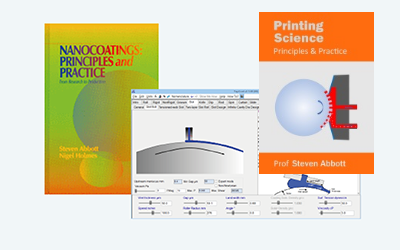Walker-Fetsko
Quick Start
Printing is about ink transfer from plate/cylinder to substrate. It's useful to know what % of the ink gets transferred. When there's very little ink being printed onto paper, the % transfer is low. At some point, the absorption of ink into the paper gives a boost to % tranfer. As some other point, that boost is such a small fraction, you don't notice it. The classic way to think of this is via the Walker-Fetsko equation with 3 parameters:
- k which affects the low ink region
- b which affects the ink absorption portion
- f which is the overall split ratio when there is a lot of ink
Walker-Fetsko
When an ink is printed onto a substrate from an offset blanket there is a ratio between the original thickness on the blanket, x and the final amount on the substrate, y. There are a number of possibilities for the transfer ratio y/x:
- For a perfect blanket and substrate, the ratio=50%.
- For a very rough substrate and very low pressure, there is so little contact that most of the ink gets no chance to transfer, so the ratio will be, say, 10%.
- If the ink is of low viscosity and the substrate is porous, plenty of ink will enter the substrate so the ratio will be, say, 70%
- At large ink thicknesses, the extra ink in the substrate is a small proportion so the ratio tends to the default value, f.
The Walker-Fetsko equation (shown below) is not at all perfect, but it is commonly used to describe the general shape. In addition to the factor f, it depends on k which describes how perfectly smooth the substrate is, with 0 being very rough and higher values being smoother (above 10 it makes little difference). Then b describes how much ink is absorbed into the substrate. Because k and b are not independent and depend on speed, pressure, ink viscosity etc. they are not deeply meaningful parameters. It can even be argued that b affects f: a rough surface might encourage cavitation away from the centre of the film, so f will be less than the theoretical value of 0.5. The tack/cavitation characteristics of the ink which depend on speed, fount etc. will also affect f on rough surfaces. Many other equations attempt to link the transfer to more fundamental parameters but have not met with much success.
By playing with the three parameters you will get a good feeling for what happens in experiments with offset. But given that the original ink thickness is seldom much larger than 2μm (giving ~1μm final deposit) most of the curve is irrelevant and the take-home message is that rough surfaces are problematic because the k effect and the b effect operate in the same region and small changes can have large effects; i.e. the printing is out of control.
Finally, here is the equation:
`y = (1-e^("-(kx)"^2)){b(1-e^(-x/b)) + f(x-b(1-e^(-x/b)))}`


